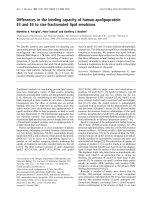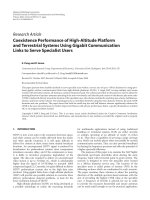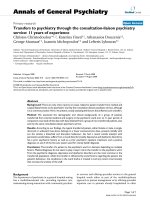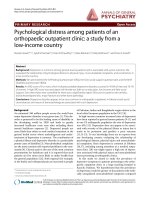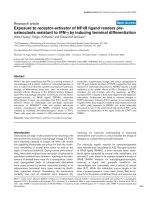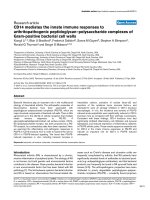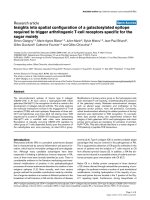Báo cáo y học: "Steppingstones to the implementation of an inhospital fracture and dislocation registry using the AO/OTA classification: compliance, completeness and commitment" docx
Bạn đang xem bản rút gọn của tài liệu. Xem và tải ngay bản đầy đủ của tài liệu tại đây (911.42 KB, 9 trang )
ORIGINAL RESEARCH Open Access
Steppingstones to the implementation of an
inhospital fracture and dislocation registry using
the AO/OTA classification: compliance,
completeness and commitment
Terje Meling
1*
, Knut Harboe
1
, Astvaldur J Arthursson
1,3
, Kjetil Søreide
2,3
Abstract
Background: Musculoskeletal trauma represents a considerable global health burden, however reliable population-
based incidence data are scarce. A fracture and dislocation registry was established wi thin a well -defined
population. An audit of the establishment process, feasibility of the registry work and report of the collected data is
given.
Methods: Demographic data, fracture type and location, mode of treatment, and the reasons for the secondary
procedures were collected and scored using recognized systems, such as the AO/OTA classification and the
Gustilo-Anderson classification for open fractures. The reporting was done in the operation planning program by
the involved orthopaedic surgeon. Both inpatient and day-case procedures were collected. Data were collected
prospectively from 2006 until 2010. Compliance among the surgeons and completeness and accuracy of the data
was continuously assured by an orthopaedic surgeon.
Results: During the study period, 39 orthopaedic surgeons were involved in the recording of a total of 8,188
procedures, consisting of primary treatment of 4,986 long bone fractures, 467 non long bone fractures, 123
dislocations and 2,612 secondary treatments. In the study period 532 fractures or dislocations were treated at least
once for one or more serious complications. For the index yea r of 2009, a total of 5710 fractures or dislocations
were treated in the emergency department or hospitalized, of which the 1594 (28%) were treated at the inpatient
or day-case operation rooms, thus registered in the FDR. Quality assurance, educational incentives and continuous
feedback between coders and controller in the integrated electronic system are available and used through the
features of the electronic database.
Conclusions: Implementing an integrated registry of fractures and dislocations with the electronic hospital system
has been possible despite several users involved. The electronic system and the data controller provide for
completeness and validity. The FDR has become an indispensable tool for the department for planning and
education and will serve as a prerequisite for the conduct and execution of future prospective trials within the
department. Further, other departments with similar electronic patient files may fairly easily adopt this system for
implementation.
* Correspondence:
1
Department of Orthopaedic Surgery, Stavanger University Hospital,
Stavanger, Norway
Full list of author information is available at the end of the article
Meling et al. Scandinavian Journal of Trauma, Resuscitation and Emergency Medicine 2010, 18:54
/>© 2010 Meling et al; licensee BioMed Central Ltd. This is an Open Access article distributed under the terms of the Creative Commons
Attribution Lice nse ( w hich permits unrestricted use, distri bution, and reproduction in
any medium, provided the original work is prop erly cited.
Background
Major trauma is a leading cause of death and disability
around the world [1]. In Scandinavia, the incidence of
severe injury ranges from 30 to 52 per 100,000 inhabi-
tan ts annuall y, with about 90% due to blunt trauma [2].
Notably, musculoskeletal injuries are very common and
represent a considerable global health burden, and long
bone fractures take up five of the top ten most frequent
non-fatal injuries sustained after trauma worldwide [3].
Fractures alone account for significant morbidity during
childhood as well as in the elderly, albeit different frac-
ture patterns are known to occur [4-6]. Although data
exist on musculoskeletal injury epidemiology, discre-
pancy in the aim and focus of most studies hampers
drawing firm conclusions. Further, it is often difficult to
find common data sets and definitions when comparing
national statistics of injury [7-10]. Thus, the literat ure is
somewhat conflicting in the incidence reports of frac-
tures as de finitions, access to data, and diagnostic sys-
tems differ widely [6,11-15].
Consequently, heterogeneity is widely present among
the studies, and, d rawing firm conclusion from any one
study is thus hampered. To the best of our knowledge
there is a paucity of prospective, population-based
studies investigating the incidence patterns of age- and
sex-specific patterns of long bone fractures requiring
inpatient or day-case procedures. This contrasts the
WHO call for increased focus on these injuries, both in
high-income and low-income countries [16].
The aim of this study is to audit the experience and
present the steppingstones to the implementation and
establishment of an inhospital-based registry of all frac-
tures and dislocations requiring inpatient or day-case
treatment in a Norwegian trauma centre using the
recognized orthopaedic fracture AO/OTA classification
system.
Methods
Study population
Stavanger University Hospital (SUH) serves as the only
primary trauma and emergency care facility for a mixed
population of about 317,000 inhabitants (2008 statistics)
[17] in the South-Western part of Norway. The SUH
orthopaedic department, in principle, covers all aspects
of general orthopaedic trauma and non-trauma ortho-
paedic surgery for all age groups, with some exceptions
(e.g. complex fractures of the pelvic ring and the aceta-
bulum, fractures and dislocations of t he face, head,
neck, complex fractures of the hand and some of the
fractures of the thoracic and lumbar spine).
The primary catchment area has an urban: rural ratio
of about 5:1 [17]. While having a growing population,
the SUH serves as the only primary health care facility
for the population under investigation and, thus, provid-
ing for reliable incidence and epidemiological investiga-
tions of disease in this region over time. Consequently,
the study population should be well representative of
other Western, non-metropolitan regions.
Inclusion and exclusion criteria
Included in the FDR are all procedures performed for
fractures or dislocations, which required inpatient or
day-case procedures at the operation rooms by the
orthopaedic department at SUH. Secondary procedures
(reoperations and revision surgery) are also included.
Current study period was June 19
th
, 2006 until March
10
th
, 2010.
Treatments performed in the emergency department
are not included, e.g. fractures solely given plaster cast,
with or without reduction. As closed reduction and plas-
ter casting of children are most often done in general
anaesthesia, these procedures are included in the FDR.
Procedures to patients living outside the region, but
treated at SUH are included. Fractures operated in other
departments than the orthopaedic department (e.g. plas-
tic & reconstructive surgery; neurosurgery) at SUH are
not included. Patients of all ages are included.
Data collection and database
After a two and a half year period of running a manual
registry (data not reported ), the digital registration into
the electronic FDR started, and as such represents the
current period of this study, starting as of June 19th,
2006.
TheFDRBoarddecidedthevariablesincludedinthe
FDR. The Board also approved the FDR protocol, which
includes the history, the aim, the definitions, and the
var iables of the FDR. Any given change will be listed in
the protocol. Ahead of the digital introduction the sur-
geons went through a teaching program which included
digital assignments. All orthop aedi c operations are con-
secutively regist ered by the orthopaedi c surgeon in
charge of treatment (figure 1) into the operation plan-
ning program ORPlan. The ORPlan programme includes
a fracture and dislocation module where all the data to
theFDRareregistered.Both primary and secondary
procedures, along with the reasons for the secondary
procedures, are registered.
To ensure the quality, the parameters are recorded as
alternatives in scroll-down menus. There is an extensive
use of tool tips, containing definitions and explanations.
The fracture classification coding is done in a stepwise
manner. First the fractured bone is chosen (e.g. femur),
then the bone segment (e.g. shaft). Finally the correct
AO/OTA-type and AO/OTA-group is chosen by select-
ing the most correct definition for each different AO/
Meling et al. Scandinavian Journal of Trauma, Resuscitation and Emergency Medicine 2010, 18:54
/>Page 2 of 9
OTA-group. Simultaneously the illustration of each cho-
sen AO/OTA-group is shown (figure 1). Depending on
the AO/OTA code and the fixat ion devices noted
ORPlan suggests the diagnose (ICD-10) and the proce-
dure (NCSP).
Any given operational event may have one or more
procedures (for instance bilateral fracture treatment of
the distal radius) and, accordingly, there is a registered
procedure for every fracture or dislocation. The ORPlan
includes fracture registry reports available for all sur-
geons involved to check for content. Furthermore, more
advanced reports are available for the controller for
extracting data.
Anaesthesiologists, nurses and surgeons all use the
program for planning, scheduling and registration of all
operative procedures. The program ensures complete
coverage of all patients admitted for surgery or treat-
ment under general anaesthesia, as it is only possible to
operate when a patient is scheduled in the program.
Features of the FDR are given in table 1.
Description of the database working key
ORPlan is an operation planning program which
includes a fracture and dislocation registering module.
The system is currently based on a SQL Server (Micro-
soft(tm)) and thin clients made in VB.net.
Classification
The Regist ry is based on the Müller-classification of long
bone fractures [18] and the Orthopaedic Trauma Asso-
ciation’s(OTA’ s) Fracture and dislocation classification
compendium - 2007 [19]. Fractures are scored based on
the best knowledge of the surgeon obtaine d at the end of
the op eration as informed by both radiological as well as
surgical exposure. In principal, intraoperative findings,
and preoperative X-ray plain films are almost always
Trauma
event
DIAGNOSIS
Fracture and/or
dislocation
MANAGEMENT
Fracture and/or
dislocation
Clinical
X-ray
CT
MRI
In-hospital or
Day-case
procedure
Education
Epidemiology
Quality control
Outcomes research
F&D Registry
F&D Registry
AO/OTA classification
AO/OTA classification
Surgeon coding
Figure 1 Flow chart of Registry use. Flow chart of the use of the FDR in the orthopaedic department.
Meling et al. Scandinavian Journal of Trauma, Resuscitation and Emergency Medicine 2010, 18:54
/>Page 3 of 9
included, but often also compu ted tomography with or
without three-dimensional (3D)-reconstructions or mag-
netic resonance imaging in a select manner.
Data control
A control of the registered parameters and completion
of data is continuously performed by one orthopaedic
surgeon (Terje Meling). The process follows several
steps to ensure completeness and validity. For one, the
ORPlan is month ly searched for non-c oded orthopaedic
operational events. Second, the operational protocol
procedures, not reported as fractures or dislocations , are
monthly searched for procedures which still should be
reported to the FDR. Third, most of the patients’ opera-
tion- notes are briefly searched for completion and qual-
ity assurance of the parameters. Close atte ntion is being
paid to the following:
a) The registration of whether the fracture event
previously has been treated at SUH (outpatient or
inpatient), or at another hospital (i.e. reason for
inclusion or exclusion);
b) If the fixation method used is correctly reported;
c) If any secondary procedures are not correctly
linked to the primary procedure registration;
d) If the indications for the secondary procedures
are correctly reported, and;
e) If the o pen fractures and pathological fractures
are correctly reported. Finally, most of the patients
x-rays are reviewed to ensure t he AO/OTA fracture
and dislocation classification a nd to ensure that
simultaneous dislocations are registered, if present.
ORPlan includes a feedback reporting system. Thus
written feedback is given (from the controller) to the
coding surgeons when important failures or discrepan-
cies are found in the registrations. When the surgeon
enters the ORPlan for the next time the feedback report
pops up on the screen.
Definitions
Fractures
Fractures are defined as a single or multifragmentary
circumferential disruption of a diaphysis or metaphysis
or a single disruption of an articular surface [18,20]. In
the immature skeleton the disruption might not be
complete. Hence bowing, torus and greenstick fractures
are classified as fractures in the Fracture and dislocat ion
classification compendium for children [21]. Each of the
long bones were, according to Müller, [18] divided into
the proximal, diaphyseal, or distal segment. Only one
fracture was registered in one bone segment at any one
occasion. Usually one fracture is counted even if more
than one segment of a bone is fractured, depending on
the fracture pattern. The long bones are classified into
fracture group, using four signs of the AO/OTA classifi-
cation. The non long bone fractures are only classified
into fracture segment (the two first signs of the classifi-
cation). Open fractures are s cored according to the
modified Gustilo-Anderson classification [22,23].
Dislocations
Dislocations are defined as displacement of the main
part of one side of the joint which needs immediate
reduction. Or when the main intraarticular surface is or
has been dislocated more than one third of the width of
the joint. The dislocation is described by the AO/OTA
segments proximal and distal to the joint. For instance
an elbow dislocation is called 13-21, and a dislocation of
the syndesmotic joint in the ankle is called 43-43. Frac-
tures with dislocation of the joint are classified both as
fractures and dislocations.
Primary and secondary procedures
As each fracture in any patient may be operated on at
several times, any first procedure (e.g. a fixation of a
Table 1 Features of the FDR
Feature Comment
Feasibility and
systems integration
Integration with daily practice and OR planning
Well-tailored software for integration
Integration with electronic hospital files
Integrated with coding records (diagnosis and procedures; e.g. ICD-10 and NCSP/NCMP)
Compliance Integrated with planning and registration of all operative procedures
User friendly working tool among surgeons
Step-by-step approach for completing data
Use of recognized scoring system (AO/OTA) and Gustilo-Anderson (open fractures)
Education Integration of AO/OTA coding with illustrated definitions and descriptions
Feedback by controller
Data for internal review and education
Quality assurance Data controlled, corrected and completed by an orthopaedic surgeon
Allows regularly or periodic overview of procedures and complications in department
Allows for data extraction at individual/surgeon, procedure or fracture/dislocation, or/and department level
Allows for prospective trials and studies.
Meling et al. Scandinavian Journal of Trauma, Resuscitation and Emergency Medicine 2010, 18:54
/>Page 4 of 9
femoral neck fracture with collum screws) is called the
primary procedure. Any subsequent procedure (e.g.
need for removal of the screws and subsequent hemiar-
throplasty) is thus referred to as a secondary procedure.
In addition, all secondary procedures are linked to the
original, or index treatment of the fracture, so as to
allow complete tracking of all subsequent procedure s
for any given injury in a patient. Each injury might have
many secondary procedures. Indications for the second-
ary procedures are registered accordingly. Each second-
ary procedure might be performed for more than one
indication/reason. Consequently, the secondary proce-
dures and the indication (e.g. planned or, requi red from
primary treatment failure) constitute the quality mea-
sure of the fracture and dislocation treatment in the
department. Some of the reasons are more serious than
others and represent the severe complications (table 2).
Only complications that involve a procedure at the
operation are registered.
Calculated are, 1) the numbers of secondary proce-
dures, 2) the numbers of indications and 3) the numbers
of injuries (fractures or dislocations) requiring secondary
procedures. For instance a hip fracture primary treated
with hip screws required three secondary procedures: a)
Replacement by total hip-arthroplasty because of metal
failure, secondary arthritis and non-union. b) and c)
Two wound debridement due to deep infection. 1)
Three secondary procedures, 2) four serious indications,
and 3) one fracture are measured.
Study ethics
The registry is approved by the Norwegian Social
Science Data Service. Consent for this quality assurance
project is given by the Regional Ethics Committee.
Statistical analysis
The data reported herein are descriptive and no statisti-
cal comparison has been performed.
Table 2 Indications for performing secondary procedures either by intention (planned, scheduled) or, based on failed
primary (index) management
Indications for secondary procedures (reoperations)
Severe complications or major events 1 Wound disruption
2 Deep infection
3 Deep hematoma
4 Refracture (inadequate trauma)
5 Peri-implant fracture
6 Osteonecrosis
7 Delayed/non union
8 Malunion
9 Posttraumatic arthritis
10 Implant broken through joint surface
11 Implant failure
12 Loosening of arthroplasty material
13 Dislocation after hemiarthroplasty
14 Dislocation after total joint replacement
15 Debridement (secondary soft tissue damage)
16 Other (serious reasons)
Mild complications or minor events 17 Failed index conservative procedure
18 Superficial infection
19 Superficial hematoma
20 Refracture (adequate trauma)
21 Discomfort from osteosynthetic material
22 Other (inconvenient reasons)
Planned/intended events 23 Debridement (primary soft tissue damage)
24 Planned final fixation
25 Routine metal removal
26 Other (intended reasons)
Meling et al. Scandinavian Journal of Trauma, Resuscitation and Emergency Medicine 2010, 18:54
/>Page 5 of 9
Results
During the study period 8,188 procedu res were
recorded, consisting of primary treatment of 4,986 long
bone fractures, 467 non long bone fractures, 1 23 dislo-
cations (without fracture) and 2,612 secondary treat-
ments. In the same period 532 fractures or dislocations
were treated at least once for one or more severe com-
plications (defined in table 2). The incidence patterns
for primary procedures of long bone fractures (all trea-
ted at the SUH) in this population has been described
in detail elsewhere [4]. Baseline characteristics in the
current study are given in table 3.
Adult population (≥ 16 years of age)
In the a dult age group, women constituted 59% of the
primary treatments and 47% of the se condary treat-
ments. For the primary treatments the median age for
women was 73 years, and for men 49 years of age.
The most frequently fractured long bone segments were
the proximal femur (40%), the dist al forearm (22%) and
the ankle (16%). Secondary procedures for the long
bone fractures were most often recorded for fractures in
the ankle (27%) and in the proximal femur (23%).
Children (< 16 years of age)
Girls made up a total of 40% of the primary treatments
and 38% of the secondary treatments. For t he primary
treatments the median age among the children was 9
years for girls and 10 years for boys. The most fre-
quently fractured long bone segments among the chil-
dren were the distal forearm (38%), the diaphyseal
forearm (25%) and the distal humerus (15%). Secondary
procedures for the long bone fractures were most often
executed in the shaft of the forearm (29%) and in the
distal humerus (27%).
Non long bone fractures and dislocations
The most common primary treated non long bone frac-
tures and dislocations are presented in table 4.
Day-case surgery
Fractures treated primarily as day-case surgery increased
from 2007 to 2009, (data not shown). However, the
overall numbers were small compared to the total in-
hospital management. The overall number of primary
treatments increased during the study period, whereas
the secondary treatments did not. Notably, almost one-
third of all secondary treatments where performed as
day-case procedures (mostly uncomplicated hardware
removals).
Emergency unit
For the index year of 2009, a total of 5710 fractures or
dislocations were treated in the emergency department
or hospitalized, of which 1594 (28%) were treated at the
inpatient or day-case operation rooms and registered in
the FDR.
The study region
If the patient acquires a fracture when travelling outside
the region, the primary treatment will be performed at
another hospital and, consequently, not recorded in the
FDR. The Statisti cs Norway reported, for the index year
of 2006, the numbers of inhospital patients living in our
region treated for long bone fractures (ICD-10 codes;
S42, S52, S72 and S82). The data were divided into
those treated at SUH and those treated elsewhere. Seven
per cent of the patients had their primary treatment at
another hospital. Simultaneously, five per cent of the
primary treated fractures, recorded in the FDR, had
their residency located outside the region.
Feasibility and compliance
During the study period all the 39 orthopaedic surgeons
involved with fracture treatment recorded a mean of
208 (range 2-652) procedures to the Registry. The 39
surgeons were all department surgeons in charge in the
majority (99%) of the procedures. Guest-surgeons, trai-
nees or surgeons from other surgical specialties at SUH
Table 3 Baseline characteristics of data in the FDR
Sex Type of treatment Type of injury
Female
N
(%)
Male
N
(%)
Primary
†
N
(%)
Secondary
‡
N
(%)
LBF *
N
(%)
NLBF **
N
(%)
Dislocation ***
N
(%)
adult 3793 (55) 3128 (45) 4666 (67) 2255
(33)
6053
(88)
708
(10)
160
(2)
child 501 (40) 766 (60) 910
(72)
357
(28)
1184
(93)
58
(5)
25
(2)
† The first time a fracture was treated at the operation.
‡ Subsequent treatments.
* Fracture with or without dislocation in long bones; humerus, radius, ulna, femur, tibia or fibula.
** Fractures with or without dislocation in other bones (non long bone fractures).
*** Dislocations without any significant fracture.
Meling et al. Scandinavian Journal of Trauma, Resuscitation and Emergency Medicine 2010, 18:54
/>Page 6 of 9
were in charge of the remaining 1% of the registered
procedures, thus recorded by the orthopaedic assistant.
Assuming optimal soft- and hard-w are conditions, the
four-stage validation and completion process (, as
described above,) takes about 1-2 days work (12-15
hours) per month. There has not been a complete mea-
surement of the exact number of missing or misclassi-
fied registrations that has eventually been completed or
corrected during the study period. However, as a proxy
for evaluation of the above described validation process,
the following has been done:
For the first and second step one month was arbitra-
rily selected (August 9
th
until September 8
th
2010):
First step: Nine out of 371 (2%) orthopaedic proce-
dures were not coded. Of these one procedure was due
to fracture (or dislocation) and should have been
included in the FDR.
Second step: A total of 11 out of 21 1 (5%) procedures
were misclassified as non-fracture/dislocation proce-
dures thus had to b e recoded into the FDR. All of the
registrations misclassified were secondary procedures.
Seven of those were repeated wound debridement either
for deep infection or soft tissue damage,andtwowere
routine metal removals.
For the third step the arbitrarily chosen index months
October and November 2009 were evaluated for correct-
ness as mentioned in a-e:
a) Four out of 346 (1%) procedures were not related
to any fracture or dislocation, consequently had to
be removed from the FDR.
b) Four out of 127 (3%) secondary procedures failed
to be marked in the check box: Former inpatient
procedure at SUH.Twooutof8(13%)failedinthe
check box: Former treated at another hospital.
c)Twooutof346(0,6%)oftheregistrationsofthe
Main fixation method were corrected.
d) Three out of 127 (2%) secondary procedures were
not correctly linked to their index treatment.
e) Ten out of 127 (8%) secondary procedure registra-
tions were corrected for one or more of the indica-
tions considered serious (table 2).
For the fourth step the arbitrarily year of 2008 were
chosen. The controller changed the AO/OTA four-sign-
code in 312 out of 1319 (24%) of the long bone frac-
tures, in two out of 118 (2%) of the two-sign-code for
the non long bone fractures and in one out of 27 (4%)
dis locations. 140 out of 186 (75%) fractures with simul-
taneous dislocation missed the dislocation code.
During the l ast year of the study period, a total of 120
feedbacks were written to the surgeons.
Discussion
This study describes important steppingstones to the
implementation and use of a fracture and dislocation
registry in a busy orthopaedic department. We believe
the compliance among the involved number of surgeons
have been satisfactorily high throughout the study per-
iod and in large parts driven by the electronically inte-
grated database system, which allows for both
scheduling of surgery as well as coding of the named
Table 4 Fractures and dislocations (counted at their primary treatment)
Bone site (segment) Code † N % Bone site (segment) Code† N % Joint Code‡ N%
Prox Femur 31 1653 33 Metacarpal 77 99 21,2 Acromeoclavicular 15-14 31 25
Distal forearm 23 1211 24 Clavicle 15 79 16,9 Elbow 13-21 28 23
Ankle 44 682 14 Hindfoot * 65 13,9 Hip 62-31 14 11
Forearm diaphyseal 22 267 5 Phalangeal (Hand) 78 62 13,3 Humeroscapular 14-11 13 11
Femoral shaft 32 198 4 Metatarsal/phalangeal (Foot) 87/
88
62 13,3 Lis Franc 85-87 9 7
Prox forearm 21 173 4 Patella 34 43 9,2 Syndesmotic 43-43 7 6
Distal humerus 13 168 3 Pelvic ring 61 16 3,4 Metatarsal or phalangeal ** 4 3
Distal tibia 43 164 3 Lumbar spine 53 13 2,8 Distal radioulnar 23-23 2 2
Tibial shaft 42 155 3 Other 28 6,0 Other 15 12
Proksimal tibia 41 112 2
Proximal humerus 11 107 2
Distal femur 33 54 1
Humeral shaft 12 42 1
Total 4986 100 Total 467 100 Total 123 100
† OTA classification code; bone segment (version 2007).
‡ Proximal and distal bone segment (OTA 2007) involved in the dislocation.
* OTA classification code (2007): 81, 82, 83, 84 and 85.
** 87-87, 87-88 or 88-88.
Meling et al. Scandinavian Journal of Trauma, Resuscitation and Emergency Medicine 2010, 18:54
/>Page 7 of 9
injuries. Complet eness has been assured with only
minor deviations and need for corrections by the con-
troller. The latte r has been instrumental in maintaining
the registry and, as such, emphasizes the commitment
needed to run a quality assurance database in routine,
clinical practice.
Most studies regarding the incidence of fractures con-
sider both inpatient and outpatient treatments [6,24].
The freq uent bone bruises, the compression fractures of
the vertebras and the undisplaced or even incomplete
fissures to the nose, ribs, fingers and toes are not con-
sidered in the current study. Rather, the indication for
surgery is a crucial criterion for the recording rate to
the FDR. Of the inpatient and outpatient fractures or
dislocations that occurred in the catchments area of
SUH (for the index year of 2009) some 28% were treated
in the inpatient or day-case operatio n rooms. This find-
ing is consistent with the hospitalized number of
patients (about one third) reported from Trondheim,
Norway [24].
Some limitations to the current registry need to be
mentioned. For one, the injury mechanism is not regis-
tered in the FDR. The surgeon does not always have the
exact knowledge, thus the timing of the registration for
this issue is not optimal. Ho wever, the purpose of the
FDR is more related to the quality of the fracture treat-
ment than to the prevention of traumas. However, this
aspect needs further consideration in the future.
Second, dislocations are, while not being fractures,
also closely related to the skeleton. Dislocations are not
as frequent as fractures, but undoubtedly clinically
important and may be disabling for the pat ient. Instead
of excluding the dislocations we have included them as
a special entity in the current registry. The Fracture and
dislocation classification compendium of OTA [19]
includes a special classification for dislocations. The
compendium does not include the definition o f a dislo-
cation. The classification of the joint involved is not
very desciptive. Consequently, the dislocations may be
better descibed by the proximal and distal AO-segment
involved (e.g. tibiofemoral dislocations were recorded as
33-41 and patellofemoral as 33-45). Often the disloca-
tionshaveasubsequentbonyavulsion,inthecaseof
which the fracture-dislocation will receive both a frac-
ture- and a dislocation-code. However, likely based on
the somewhat unclear definition and recording format,
the registration of the simultaneous dislocation in frac-
ture-dislocations was the most frequently missing cod-
ing. Also, secondary procedures and especially their
indications were more often missed or misreported,
before correction. As such, “problem areas” have been
identified in the coding practice; these findings have
imposed some structural changes in the registering for-
mat in ORPlan. We believe the structural steps for
quality assurance as explained above have ensured a
high completeness rate in the registry.
Third, while being the most widely used c lassificatio n
system for orthopaedic trauma internal validity of the
AO/OTA-classification has been questioned [19]. We
believe the use of scroll-down menus with illustrations
and definitions used in the FDR, the timing of the cod-
ing in relation to admission and treatment by all ortho-
paedic surgeons and the continuous control ensure
reasonable validity. However, to substantiate this v iew a
more extensive project investigating coding validity and
reliability is being undertaken and will be presented
separately.
Hospital registries serve many purposes and might be
beneficial for the patient, physicians and administrators
[25]. National registries like the National Hip Fracture
Registry in Norway have immediate advantages concern-
ing the large numbers [26]. Both the primary and sec-
ondary treatments are considered even if procedure is
performed at other hospitals in the country. Notably,
the more uniform diagnosis and management in a single
hospital makes the data easier to present and compare.
The development and implementation of a regist ering
soft-ware that can be inter-linked with each hospital’s
electronic files may be difficult to perform. As is the
experience in this project, it would be necessary to have
a committed controller [25] to ensure high compliance
and completeness.
The FDR has become a natural part of the departmen-
tal routines for scheduling , planning and evaluation of
fracture and dislocation management in our department.
Further, it is used as educational feedback and quality
assurance tool at both individual and departmental
levels.
Conclusions
Implementing an integrated registry of fractures and dis-
locations with the electronic hospital system has been
possible despite several users involve d. The electronic
system and the data controller provide for compliance
and completeness. The system contains available registry
reports for the surgeons. The FDR has become an indis-
pensable tool for the department for planning and edu-
cation and will serve as a prerequisite for the conduct
and execution of future prospective trials within the
department. Further, other departments with similar
electronic patient files could fairly easily adopt this sys-
tem for implementation.
Abbreviations
AO: Arbeitsgemeinschaft für Osteosynthesefragen; FDR: Fracture and
Dislocation Registry at Stavanger University Hospital; ICD-10: International
Classification of Diseases; NCSP: The Nordic Medico-Statistical Committee
Classification of Surgical Procedures; NOMESCO: Nordic Medico-Statistical
Meling et al. Scandinavian Journal of Trauma, Resuscitation and Emergency Medicine 2010, 18:54
/>Page 8 of 9
Committee; ORPlan: Operation Room Planning Program; OTA: Othopaedic
Trauma Association; SUH: Stavanger University Hospital.
Acknowledgements
We highly appreciate the work of former colleague Lars Eilertsen, MD who
made a preliminary template for the fracture and dislocation registration
format in the ORPlan.
Author details
1
Department of Orthopaedic Surgery, Stavanger University Hospital,
Stavanger, Norway.
2
Department of Surgery, Stavanger University Hospital,
Stavanger, Norway.
3
Department of Surgical Sciences, University of Bergen,
Bergen, Norway.
Authors’ contributions
TM is the supervisor of the registry, carried out control of completeness and
accuracy of the register and contributed to data extraction and writing. KH
made the operation planning program; ORPlan and contributed to the data
extraction. AJA contributed in the planning and participated in the writing
process. KS greatly participated in the design and writing of the study. All
authors read and approved the final manuscript.
Competing interests
The authors declare that they have no competing interests.
Received: 11 June 2010 Accepted: 18 October 2010
Published: 18 October 2010
References
1. Søreide K: Epidemiology of major trauma. Br J Surg 2009, 96(7):697-698.
2. Kristiansen T, Søreide K, Ringdal KG, Rehn M, Kruger AJ, Reite A, Meling T,
Naess PA, Lossius HM: Trauma systems and early management of severe
injuries in Scandinavia: Review of the current state. Injury 2010,
41(5):444-452.
3. Mock C, Cherian MN: The global burden of musculoskeletal injuries:
challenges and solutions. Clin Orthop Relat Res 2008, 466(10):2306-2316.
4. Meling T, Harboe K, Soreide K: Incidence of traumatic long-bone fractures
requiring in-hospital management: a prospective age- and gender-
specific analysis of 4890 fractures. Injury 2009, 40(11):1212-1219.
5. Buhr AJ, Cooke AM: Fracture patterns. Lancet 1959, 1(7072):531-536.
6. Court-Brown CM, Caesar B: Epidemiology of adult fractures: A review.
Injury 2006, 37(8):691-697.
7. Polinder S, Meerding WJ, Lyons RA, Haagsma JA, Toet H, Petridou ET,
Mulder S, van Beeck EF: International variation in clinical injury incidence:
exploring the performance of indicators based on health care,
anatomical and outcome criteria. Accid Anal Prev 2008, 40(1):182-191.
8. Bazarian JJ, Veazie P, Mookerjee S, Lerner EB: Accuracy of mild traumatic
brain injury case ascertainment using ICD-9 codes. Acad Emerg Med 2006,
13(1):31-38.
9. Lawrence BA, Miller TR, Weiss HB, Spicer RS: Issues in using state hospital
discharge data in injury control research and surveillance. Accid Anal Prev
2007, 39(2):319-325.
10. Lofthus CM, Cappelen I, Osnes EK, Falch JA, Kristiansen IS, Medhus AW,
Nordsletten L, Meyer HE: Local and national electronic databases in
Norway demonstrate a varying degree of validity. J Clin Epidemiol 2005,
58(3):280-285.
11. Roy DK, Pye SR, Lunt M, O’Neill TW, Todd C, Raspe H, Reeve J, Silman AJ,
Weber K, Dequeker J, et al: Falls explain between-center differences in
the incidence of limb fracture across Europe. Bone 2002, 31(6):712-717.
12. van Staa TP, Dennison EM, Leufkens HG, Cooper C: Epidemiology of
fractures in England and Wales. Bone 2001, 29(6):517-522.
13. Rennie L, Court-Brown CM, Mok JY, Beattie TF: The epidemiology of
fractures in children. Injury 2007, 38(8):913-922.
14. Donaldson LJ, Reckless IP, Scholes S, Mindell JS, Shelton NJ: The
epidemiology of fractures in England. J Epidemiol Community Health 2008,
62(2):174-180.
15. McClure RJ, Cameron CM, Purdie DM, Kliewer EV: Indicators of injury
burden: which types are the most important? Int J Inj Contr Saf Promot
2005, 12(4):213-217.
16. Global burden of Disease. [ />global_burden_disease/en/], [accessed 30.09.2010].
17. Statistics Norway. [ [accessed
24.09.2010].
18. Müller ME, Nazarian S, Koch P, et al: The Comprehensive Classification of
Fractures of Long Bones. Berlin: Springer-Verlag 1990.
19. Marsh JL, Slongo TF, Agel J, Broderick JS, Creevey W, DeCoster TA,
Prokuski L, Sirkin MS, Ziran B, Henley B, et al: Fracture and dislocation
classification compendium - 2007: Orthopaedic Trauma Association
classification, database and outcomes committee. J Orthop Trauma 2007,
21(10 Suppl):S1-133.
20. Fracture and dislocation compendium. Orthopaedic Trauma Association
Committee for Coding and Classification. J Orthop Trauma 1996,
10(Suppl 1 v-ix):1-154.
21. Slongo TF, Audige L: Fracture and dislocation classification compendium
for children: the AO pediatric comprehensive classification of long bone
fractures (PCCF). J Orthop Trauma 2007, 21(10 Suppl):S135-160.
22. Gustilo RB, Mendoza RM, Williams DN: Problems in the management of
type III (severe) open fractures: a new classification of type III open
fractures. J Trauma 1984, 24(8):742-746.
23. Gustilo RB, Anderson JT: Prevention of infection in the treatment of one
thousand and twenty-five open fractures of long bones: retrospective
and prospective analyses. J Bone Joint Surg Am 1976, 58(4):453-458.
24. Sahlin Y: Occurrence of fractures in a defined population: a 1-year study.
Injury 1990, 21(3):158-160.
25. Ahn H, Court-Brown CM, McQueen MM, Schemitsch EH: The use of
hospital registries in orthopaedic surgery. J Bone Joint Surg Am 2009,
91(Suppl 3):68-72.
26. Gjertsen JE, Engesaeter LB, Furnes O, Havelin LI, Steindal K, Vinje T,
Fevang JM: The Norwegian Hip Fracture Register: experiences after the
first 2 years and 15,576 reported operations. Acta Orthop 2008,
79(5):583-593.
doi:10.1186/1757-7241-18-54
Cite this article as: Meling et al.: Steppingstones to the implementation
of an inhospital fracture and dislocation registry using the AO/OTA
classification: compliance, completeness and commitment. Scandinavian
Journal of Trauma, Resuscitation and Emergency Medicine 2010 18:54.
Submit your next manuscript to BioMed Central
and take full advantage of:
• Convenient online submission
• Thorough peer review
• No space constraints or color figure charges
• Immediate publication on acceptance
• Inclusion in PubMed, CAS, Scopus and Google Scholar
• Research which is freely available for redistribution
Submit your manuscript at
www.biomedcentral.com/submit
Meling et al. Scandinavian Journal of Trauma, Resuscitation and Emergency Medicine 2010, 18:54
/>Page 9 of 9
